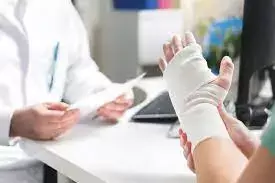- Home
- Medical news & Guidelines
- Anesthesiology
- Cardiology and CTVS
- Critical Care
- Dentistry
- Dermatology
- Diabetes and Endocrinology
- ENT
- Gastroenterology
- Medicine
- Nephrology
- Neurology
- Obstretics-Gynaecology
- Oncology
- Ophthalmology
- Orthopaedics
- Pediatrics-Neonatology
- Psychiatry
- Pulmonology
- Radiology
- Surgery
- Urology
- Laboratory Medicine
- Diet
- Nursing
- Paramedical
- Physiotherapy
- Health news
- Fact Check
- Bone Health Fact Check
- Brain Health Fact Check
- Cancer Related Fact Check
- Child Care Fact Check
- Dental and oral health fact check
- Diabetes and metabolic health fact check
- Diet and Nutrition Fact Check
- Eye and ENT Care Fact Check
- Fitness fact check
- Gut health fact check
- Heart health fact check
- Kidney health fact check
- Medical education fact check
- Men's health fact check
- Respiratory fact check
- Skin and hair care fact check
- Vaccine and Immunization fact check
- Women's health fact check
- AYUSH
- State News
- Andaman and Nicobar Islands
- Andhra Pradesh
- Arunachal Pradesh
- Assam
- Bihar
- Chandigarh
- Chattisgarh
- Dadra and Nagar Haveli
- Daman and Diu
- Delhi
- Goa
- Gujarat
- Haryana
- Himachal Pradesh
- Jammu & Kashmir
- Jharkhand
- Karnataka
- Kerala
- Ladakh
- Lakshadweep
- Madhya Pradesh
- Maharashtra
- Manipur
- Meghalaya
- Mizoram
- Nagaland
- Odisha
- Puducherry
- Punjab
- Rajasthan
- Sikkim
- Tamil Nadu
- Telangana
- Tripura
- Uttar Pradesh
- Uttrakhand
- West Bengal
- Medical Education
- Industry
Outcomes of Nonoperative Treatment for Displaced Metacarpal Shaft Fractures comparable to those treated operatively

Finger metacarpal fractures represent up to 31% of all hand fractures, and most can be treated nonoperatively. Whether operative treatment is superior to nonoperative treatment for oblique and/or spiral finger metacarpal shaft fractures (MSFs) is unknown. The article by Fredrik Peyronson et al has been published in ‘the journal of bone & joint surgery.’
42 patients with displaced oblique and/or spiral finger MSFs were randomized to either nonoperative treatment with unrestricted mobilization or operative treatment with screw fixation. The primary outcome was grip strength in the injured hand compared with the uninjured hand at the 1-year follow-up. Secondary outcomes were the Disabilities of the Arm, Shoulder and Hand score, range of motion, metacarpal shortening, complications, sick leave duration, patient satisfaction, and costs.
Key findings of the study:
All patients attended the 1-year follow-up.
• 22 patients were assigned to nonoperative treatment and 20 patients were assigned to operative treatment.
• The proportions of injury to the dominant hand (nonoperative group, 8; operative group, 12; p = 0.22) and of the presence of any degree of rotational deformity at randomization (nonoperative group, 10; operative group, 2; p = 0.33) differed but remained below the threshold of significance.
• In the operative group, 18 patients received fracture stabilization with interfragmentary compression screws and 2 received screws and a plate due to comminution.
• Mean grip strength relative to that in the contralateral hand was 104% (95% confidence interval [CI], 89% to 120%) in the nonoperative group and 96% (95% CI, 89% to 103%) in the operative group (p = 0.34).
• Mean metacarpal shortening was 5.3 mm (95% CI, 4.2 to 6.4 mm) in the nonoperative group and 2.3 mm (95% CI, 0.8 to 3.9 mm) in the operative group.
• In the nonoperative group, 1 minor complication was observed; in the operative group, there were 4 minor complications and 3 reoperations.
• The costs were estimated at 1,347 U.S. dollars (USD) for nonoperative treatment compared with 3,834 USD for operative treatment.
• Sick leave duration was significantly shorter in the nonoperative group (12 days [95% CI, 5 to 21 days] versus 35 days [95% CI, 20 to 54 days]) (p = 0.008).
The authors commented - “When treated with unrestricted mobilization, patients with a single spiral and/or oblique finger MSF have similar outcomes when compared with patients who were treated operatively, despite metacarpal shortening. Nonoperative treatment generates shorter sick leave duration and substantially lower costs. We conclude that nonoperative treatment with immediate mobilization should be advocated in patients with a single MSF of the type investigated in this study.
”Level of Evidence: Therapeutic Level II.
Further reading:
Nonoperative Versus Operative Treatment for Displaced Finger Metacarpal Shaft Fractures A Prospective, Noninferiority, Randomized Controlled Trial
Fredrik Peyronson, Cecilia Stalberg Ostwald et al
the journal of bone & joint surgery
volume 105- A number 2 january 18, 2023
http://dx.doi.org/10.2106/JBJS.22.00573
MBBS, Dip. Ortho, DNB ortho, MNAMS
Dr Supreeth D R (MBBS, Dip. Ortho, DNB ortho, MNAMS) is a practicing orthopedician with interest in medical research and publishing articles. He completed MBBS from mysore medical college, dip ortho from Trivandrum medical college and sec. DNB from Manipal Hospital, Bengaluru. He has expirence of 7years in the field of orthopedics. He has presented scientific papers & posters in various state, national and international conferences. His interest in writing articles lead the way to join medical dialogues. He can be contacted at editorial@medicaldialogues.in.
Dr Kamal Kant Kohli-MBBS, DTCD- a chest specialist with more than 30 years of practice and a flair for writing clinical articles, Dr Kamal Kant Kohli joined Medical Dialogues as a Chief Editor of Medical News. Besides writing articles, as an editor, he proofreads and verifies all the medical content published on Medical Dialogues including those coming from journals, studies,medical conferences,guidelines etc. Email: drkohli@medicaldialogues.in. Contact no. 011-43720751


